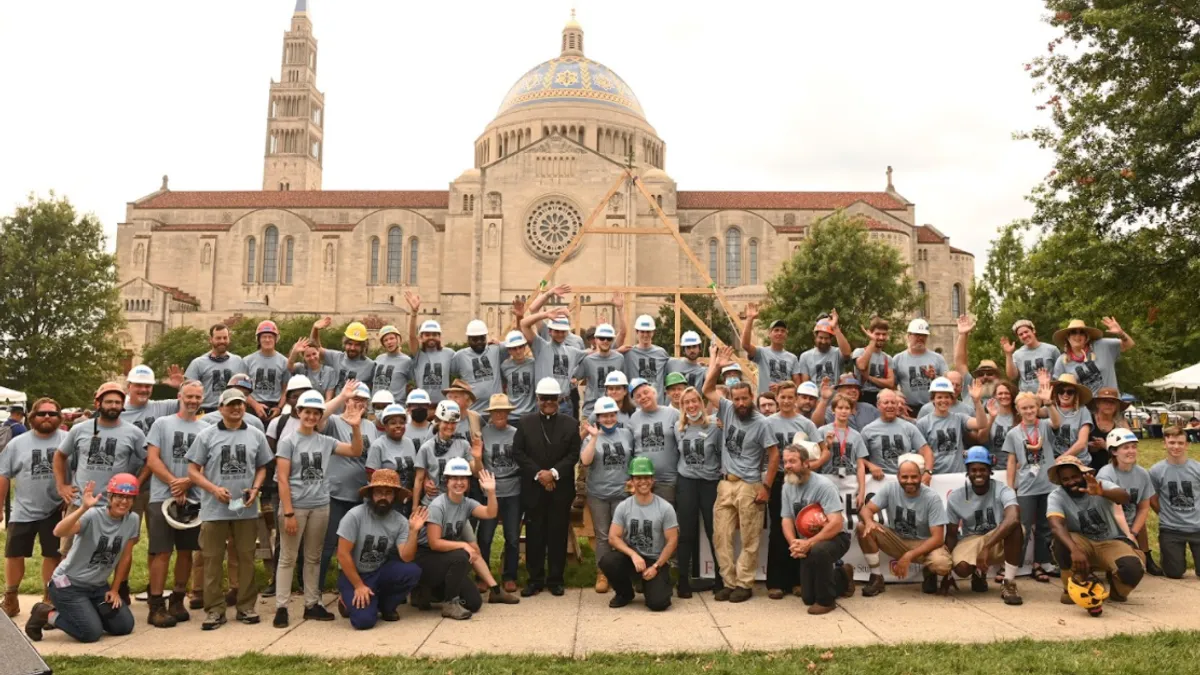The biggest goal of authenticity for Tonya Ohnstad, visiting assistant professor in the School of Architecture and Planning and the interim associate dean for graduate studies at Catholic University, isn't how the new truss was built.
It's the way it's built — with architects and builders in concert, working together instead of separately.
"For me, it's really about making, and how one of the other lecturers said, the architect and the builder split somewhere in the Middle Ages," Ohnstad said. "And for me, it's really about taking the chances for these two people to meet again and to have the chance to understand each other a little better."
At the Washington, D.C., university, Ohnstad and a group of carpenters, architecture students and volunteers are using 800-year-old methods to reconstruct a key component of the cathedral, originally constructed in 1345. Its restoration has drawn significant international attention since a fire broke out in its attic in 2019 in the midst of renovations. The blaze damaged the iconic lead spire, and also destroyed "The Forest," a group of trusses made from ancient wooden logs from a French forest almost a millennium ago.
Investigators believe that the fire was accidental and started as a result of an electrical circuit issue. Since the fire, millions of dollars have been poured into the reconstruction effort from all over the world.
French President Emmanuel Macron has pledged to rebuild the cathedral in the image of the 1844 design of Eugène Viollet-le-Duc, a French architect who oversaw restoration work on the cathedral at that time. Macron's goal is to have the project complete for the 2024 Paris Summer Olympics, a timeline that some experts have deemed unrealistic.
In addition, there has been significant debate regarding the way the cathedral is being rebuilt, with some arguing for a more modern build and others striving for historical accuracy and adherence to Viollet-le-Duc's design. In the end, a historical angle won out within reason, with adherence to new safety standards.
So far, workers have cleared out debris, and construction is expected to start in fall 2022, according to Architectural Digest.
It's with that vision that Ohnstad and company find themselves hewing Virginia logs with axes by hand in the shade of the nearby Basilica of the National Shrine of the Immaculate Conception, and using traditional joinery methods to construct a brand-new truss, which will be 45 feet wide and 35 feet tall. Some of the practices involve hewing the wood by hand with axes as opposed to with power tools, and using those medieval joinery techniques to keep the truss together and in place, accurate to the times they were used.
The recreated truss was constructed to show it was still possible to use old techniques and skills to get the work done.
A world icon
In May, Catholic University announced its participation in the program, which is led by Norwell, Massachusetts-based nonprofit Handshouse Studio, in conjunction with local partners and professional carpenters and traditional building experts from around the country. Organizations such as the National Park Service and Charpentiers sans Frontieres (Carpenters Without Borders) have helped construct the truss.
Ohnstad taught a course about the traditional construction of Notre Dame, where students learned about older joinery methods, timber harvesting and building techniques, along with creating their own scaled models of the much larger truss.
Ohnstad said she views the rebuilding process as a chance for all interested students to get involved, including people who may have been excluded at the time of the original construction. She said that the innovations may not be about the structure or the shape, but the inclusion of people, such as people of color, who were excluded from the original construction.
The truss was completed this week and received a blessing from Cardinal Wilton Gregory, archbishop of Washington, D.C., on August 5 in the shadow of the basilica.
"I think the Notre Dame is a world icon, it doesn't belong to just one person or one base or one culture, it belongs to the whole world," Ohnstad said.
This story has been edited to clarify that the truss will not be installed in the Notre Dame Cathedral.











